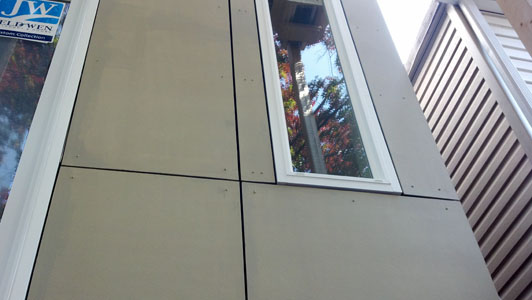“So, when are you going to finish the siding outside?”
“That’s it? You mean it stays open like that?”
I wish I had kept track of how many times I was asked those questions by various trade partners who came to work on a recent job in Mount Pleasant. They were referring to the open-joint siding panels installed on the back of the house, part of a cladding system that architects refer to as a “rain screen.”
The siding panels are held off the supporting wall by ½”, using vinyl battens. When you look at them up close, they appear to be floating there. Furthermore, not only do the panels hover ½” off the house, but none of the panels actually touch at the joints. The result is 3/8” gaps between panels that at first appear to be welcoming invitations for rain water to enter.
Although counter-intuitive, the system actually works very well at keeping a house dry—many argue its superiority over traditional siding. The ½” of air behind each panel combined with the 3/8” open joints provides plenty of opportunity for air circulation and results in pressure equalization.
What’s the significance of pressure equalization? Consider wind-driven water, a real concern for traditional siding. Because traditional siding aims to create an airtight barrier, strong winds create high air pressure on the exterior face, while all the little air spaces behind the siding are still at low pressure. This pressure differential results in the movement of air—and water—from outside to in.
Because air can circulate and pressure is equalized between the inside and outside of the rain screen panels, the pressure differential can never develop, and as odd as it seems, very little water actually migrates through those 3/8” gaps. Water that does make it through the open joints will simply drain down the backside of the panels or evaporate.
Of course, we don’t just rely on the rainscreen principle to keep the house dry. Behind the siding panels, the entire exterior wall has been entirely wrapped with a sophisticated, water-tight membrane system. More labor is actually spent meticulously applying this membrane to ensure its tightness than the siding panels themselves.
The happy coincidence behind all the theory is that the open joint panels happen to be very architecturally interesting. The look is very unique. The panels lend themselves well to a square layout with strong lines, giving the façade a clean, modern appearance. Paying special attention to layout of the fasteners allows them to remain exposed and contribute to the grid-like, borderline industrial feel. I was pleased with the final results, and I hope the system can be incorporated into future designs, regardless of the opinions of any of our trade partners.
